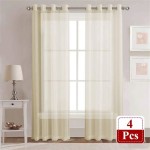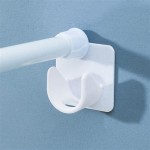Floor To Ceiling Curtains Bedroom: Enhancing Ambiance and Functionality
Floor-to-ceiling curtains, extending from the top of the wall directly to the floor, have become a prominent design element in modern bedrooms. Their ability to drastically alter the perceived dimensions of a room, control light effectively, and add a layer of sophisticated texture makes them a desirable choice for homeowners seeking to enhance both the aesthetic appeal and functionality of their private sanctuary. This article explores the benefits, considerations, and practical aspects of incorporating floor-to-ceiling curtains in a bedroom setting.
The Aesthetic Advantages of Floor-to-Ceiling Curtains
The primary advantage of utilizing floor-to-ceiling curtains is their profound impact on the visual perception of space. By drawing the eye vertically, these curtains create the illusion of higher ceilings, making a room feel larger and more airy. This effect is particularly valuable in bedrooms with lower ceilings or limited square footage. The unbroken line from ceiling to floor contributes to a sense of grandeur and elegance often associated with professionally designed spaces.
Furthermore, floor-to-ceiling curtains serve as a powerful design statement. They can act as a focal point, adding a touch of drama and sophistication to an otherwise ordinary room. The sheer variety of fabrics, colors, and textures available allows for seamless integration with any existing decor. From light and airy sheers to heavy and luxurious velvets, the aesthetic possibilities are virtually limitless. The choice of fabric can significantly influence the overall mood of the room; for instance, linen curtains can create a relaxed and casual atmosphere, while silk curtains can evoke a sense of opulence and refinement.
Beyond their visual appeal, floor-to-ceiling curtains offer a valuable opportunity to introduce texture and depth to the bedroom. This is particularly important in minimalist designs where strong architectural features may be lacking. The folds and drapes of the fabric create subtle shadows and highlights, adding visual interest and preventing the room from feeling flat or sterile. Layering different types of curtains, such as sheer curtains beneath heavier drapes, can further enhance this effect, allowing for greater control over light and privacy while simultaneously adding another dimension to the room's design.
Functional Benefits: Light Control, Privacy, and Insulation
While the aesthetic advantages of floor-to-ceiling curtains are undeniable, their functional benefits are equally compelling. One of the most significant advantages is their ability to effectively control the amount of natural light entering the room. This is particularly important in bedrooms, where achieving optimal darkness is crucial for promoting restful sleep. Blackout curtains, specifically designed to block out virtually all light, are an excellent choice for individuals who are sensitive to light or who work night shifts and need to sleep during the day.
Even without blackout lining, floor-to-ceiling curtains provide superior light control compared to shorter window treatments. Their extended length covers a larger portion of the window, minimizing light leakage around the edges. This is especially beneficial in bedrooms with multiple windows or windows that face east or south, where morning sunlight can be particularly disruptive. The ability to adjust the curtains to varying degrees also allows for precise control over the amount of light filtering into the room, creating a comfortable and inviting atmosphere at any time of day.
Privacy is another key benefit offered by floor-to-ceiling curtains. They provide a substantial barrier against prying eyes, ensuring a sense of seclusion and security within the bedroom. This is particularly important in urban environments or in homes where windows are located close to neighboring properties. The density of the fabric plays a crucial role in determining the level of privacy; thicker fabrics provide greater opacity and block out more light, while sheer fabrics offer a more translucent effect. Choosing the appropriate fabric weight is essential for balancing privacy with the desired level of natural light.
Furthermore, floor-to-ceiling curtains can contribute to energy efficiency by providing insulation. During the colder months, they help to retain heat within the room, reducing the need for excessive heating. The fabric acts as a barrier, preventing drafts and minimizing heat loss through the windows. Conversely, during the warmer months, heavier curtains can block out sunlight, reducing heat gain and keeping the room cooler. This can lead to significant savings on energy bills over time, making floor-to-ceiling curtains a practical and cost-effective investment.
Practical Considerations for Installation and Maintenance
Before installing floor-to-ceiling curtains, several practical considerations must be addressed to ensure a successful and aesthetically pleasing outcome. One of the most important factors is the selection of the appropriate curtain rod. The rod should be sturdy enough to support the weight of the curtains and long enough to extend beyond the window frame on both sides. This allows the curtains to be fully opened without blocking the window, maximizing the amount of natural light entering the room.
The placement of the curtain rod is also crucial. For floor-to-ceiling curtains, the rod should be mounted as close to the ceiling as possible to maximize the illusion of height. This can be achieved by using ceiling-mounted brackets or by installing the rod directly onto the wall near the ceiling. The distance between the rod and the window frame should be carefully considered to ensure that the curtains hang properly and do not interfere with window operation.
The length of the curtains is another critical factor. Ideally, floor-to-ceiling curtains should just graze the floor. A slight "break," where the curtains puddle slightly on the floor, can add a touch of romanticism and elegance, but excessive pooling can make the room appear cluttered and can also lead to the curtains becoming dirty or damaged. It is essential to measure the distance from the curtain rod to the floor accurately before ordering or purchasing curtains to ensure a perfect fit.
Maintaining floor-to-ceiling curtains requires regular cleaning to prevent dust and allergens from accumulating. The frequency of cleaning will depend on the type of fabric and the environment; however, a general rule of thumb is to vacuum the curtains regularly using a brush attachment. For deeper cleaning, some curtains can be machine washed, while others require professional dry cleaning. It is essential to follow the manufacturer's instructions carefully to avoid damaging the fabric.
Choosing the right fabric is vital for both aesthetic and practical reasons. Consider the amount of sunlight the room receives, the desired level of privacy, and the overall style of the bedroom when selecting the fabric. Light and airy fabrics like linen or sheer cotton are ideal for creating a bright and airy atmosphere, while heavier fabrics like velvet or brocade are better suited for creating a more dramatic and luxurious feel. The color and pattern of the fabric should also complement the existing decor and create a cohesive and visually appealing space.
Finally, consider the cost implications of floor-to-ceiling curtains. They can be more expensive than shorter window treatments due to the increased amount of fabric required. However, the investment in high-quality curtains can be worthwhile, as they can last for many years and significantly enhance the value and appeal of the bedroom. When budgeting for floor-to-ceiling curtains, factor in the cost of the fabric, the curtain rod, and any installation fees. Carefully planning and selecting the right materials can help to ensure that the project stays within budget and delivers the desired results.

Interiors Archives

Do It Floor To Ceiling Curtains Lewis S

Contemporary Apartments London Curtains Made To Measure Blinds Uk

30 Floor To Ceiling Curtains Frame Your Windows

Pin Page

Transform Your Space Curtains Design For Home

5 Ways Floor To Ceiling Curtains Will Make Your Room Look Bigger

Curtains Blinds Drapes And Shades For Windows Design Cafe

Choose Bedroom Curtains Length Long Or Short Which Is Best Dolcewe

Japanese Simple Style Curtain Balcony Floor To Ceiling Window Drapes B Aookmiya








